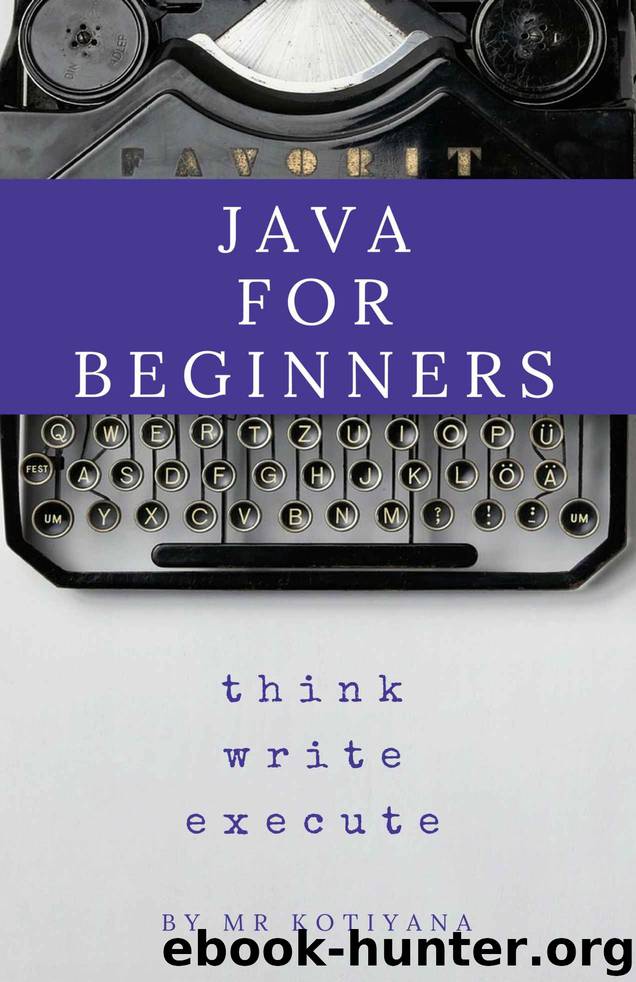Java for Beginners 2018 (Learn Coding Fast with Hands-On Project Book 4) by Mr Kotiyana

Author:Mr Kotiyana [Kotiyana, Mr]
Language: eng
Format: azw3
Published: 2018-02-17T05:00:00+00:00
An object has an interface:
So, although what we really do in object-oriented programming is create new data types, virtually all object-oriented programming languages use the “class” keyword. When you see the word “type” think “class” and vice versa.
Since a class describes a set of objects that have identical characteristics (data elements) and behaviors (functionality), a class is really a data type because a floating point number, for example, also has a set of characteristics and behaviors. The difference is that a programmer defines a class to fit a problem rather than being forced to use an existing data type that was designed to represent a unit of storage in a machine. You extend the programming language by adding new data types specific to your needs. The programming system welcomes the new classes and gives them all the care and type checking that it gives to built-in types.
The object-oriented approach is not limited to building simulations. Whether or not you agree that any program is a simulation of the system you’re designing, the use of OOP techniques can easily reduce a large set of problems to a simple solution.
Once a class is established, you can make as many objects of that class as you like, and then manipulate those objects as if they are the elements that exist in the problem you are trying to solve. Indeed, one of the challenges of object-oriented programming is to create a one-to one mapping between the elements in the problem space and objects in the solution space.
But how do you get an object to do useful work for you? There needs to be a way to make a request of the object so that it will do something, such as complete a transaction, draw something on the screen, or turn on a switch. And each object can satisfy only certain requests. The requests you can make of an object are defined by its interface, and the type is what determines the interface. A simple example might be a representation of a light bulb:
Download
This site does not store any files on its server. We only index and link to content provided by other sites. Please contact the content providers to delete copyright contents if any and email us, we'll remove relevant links or contents immediately.
Hello! Python by Anthony Briggs(10121)
The Mikado Method by Ola Ellnestam Daniel Brolund(10013)
OCA Java SE 8 Programmer I Certification Guide by Mala Gupta(9980)
Algorithms of the Intelligent Web by Haralambos Marmanis;Dmitry Babenko(8522)
Sass and Compass in Action by Wynn Netherland Nathan Weizenbaum Chris Eppstein Brandon Mathis(7915)
Grails in Action by Glen Smith Peter Ledbrook(7882)
Test-Driven iOS Development with Swift 4 by Dominik Hauser(7853)
The Well-Grounded Java Developer by Benjamin J. Evans Martijn Verburg(7770)
Windows APT Warfare by Sheng-Hao Ma(7486)
Layered Design for Ruby on Rails Applications by Vladimir Dementyev(7241)
Blueprints Visual Scripting for Unreal Engine 5 - Third Edition by Marcos Romero & Brenden Sewell(7126)
Secrets of the JavaScript Ninja by John Resig Bear Bibeault(6641)
Kotlin in Action by Dmitry Jemerov(5299)
Hands-On Full-Stack Web Development with GraphQL and React by Sebastian Grebe(4384)
Solidity Programming Essentials by Ritesh Modi(4382)
WordPress Plugin Development Cookbook by Yannick Lefebvre(4195)
Functional Programming in JavaScript by Mantyla Dan(4124)
Unity 3D Game Development by Anthony Davis & Travis Baptiste & Russell Craig & Ryan Stunkel(4110)
The Ultimate iOS Interview Playbook by Avi Tsadok(4078)
